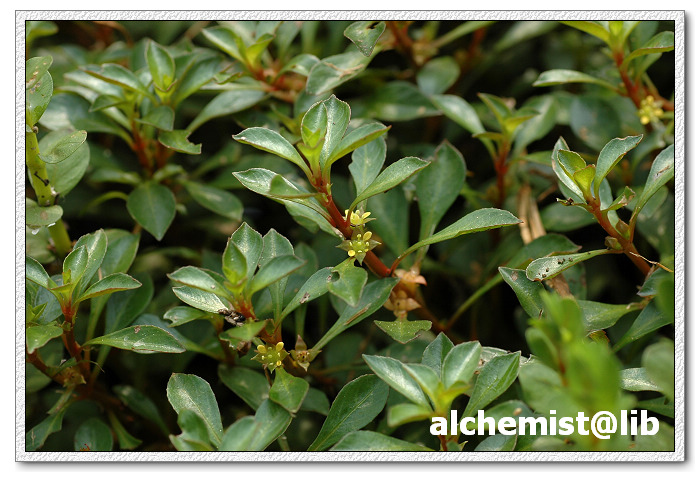- Scientific Name: Ludwigia ovalis Miq.
- Ref: Ann. Mus. Bot. Lugduno-Batavi 3:95. 1867
- English Common Name: oval ludwigia
- Chinese Common Name: 卵叶丁香蓼 luǎnyè dīngxiāng∙liǎo
- Japanese Common Name: ミズユキノシタ [水雪の下] mizuyukinoshita
- Family: Onagraceae
- Genus: Ludwigia
- Distribution: Moist places, especially on beds of lakes and ponds; 100-500 m. Anhui, Hunan, Fujian, Guangdong, Jiangsu, Taiwan, Zhejiang [Japan, Korea].
- Photo: 06/21/2009, South China Botanical Garden, Guangdong
Herbs delicate, perennial, creeping and rooting at nodes. Stems ascending, 20-45 cm tall, branched basally, subglabrous or finely puberulous. Petiole winged, to 7 mm; leaf blade ovate, 0.5-2.5 × 0.4-2 cm, glabrous, lateral veins 4-7 per side, submarginal vein absent, base abruptly attenuate, apex acute. Se- pals 4, deltoid-acute, 1-3 mm, very finely puberulous along margin. Petals absent. Stamens 4; filaments translucent, 0.5-0.8 mm, dilated below; anthers 0.6-0.9 mm, nearly basifixed; pollen in monads. Style green, 0.6-1 mm; stigma dark green, globose. Capsules elongate-globose, subterete, 3-5 mm, 2.5-3.5 mm in diam., finely puberulous, thinly walled, readily and irregularly loculicidal; subsessile or pedicel to 6 mm. Seeds in 2 or more rows per locule, free, reddish brown, apiculate, 0.7-0.9 mm, raphe inflated and triangular, 0.2-0.5 mm across, coarsely reticulate. Fl. Jul-Sep, fr. Jul-Oct. 2n = 32. (Flora of China)
